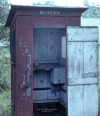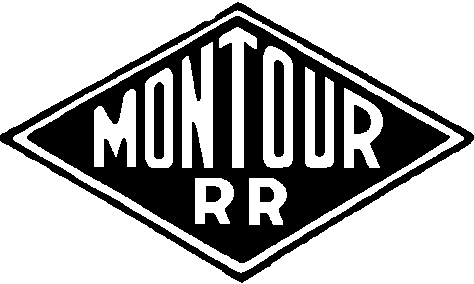Montour Railroad
Mileposts
Bridges
History
Maps
Roster
Mines
Links
Gallery
Working on the
Montour
Schaeffer
Stories
Sposato
Stories
Employees
Railroading
101

|
|
Tim
Sposato Stories
Montour RR Wayside
Telephone Booths









|
|
 Here is on original phone booth (Gene P. Schaeffer photo)
Here is on original phone booth (Gene P. Schaeffer photo) |
|
- Montour
RR Wayside Telephone Booths
Patented July 17, 1894
Any
given railroad is filled with potential stories, the Montour is no
exception. I like to believe that the Mighty “M” equals and exceeds
other Pikes when comparing their histories and tales.
Communications
were of the common railroad standard in the MRR early days. Telegraph
was the system between Imperial and Montour Jct. Imperial
being
the telegraph office for railroad and Western Union
business. Around the turn of the century
Western
Electric had perfected the use of telephones, railroads immediately
realized the additional benefits to its use. The new
technology
of the times allowed the railroad to replace the telegraph, though for
over many years both types of communication worked side by side.
As
the transition to telephones occurred, the appearance of wood telephone
booths and pole mounted phone boxes became a common sight at the
majority of MRR siding switches, spurs and tool houses and so
forth. The Dispatcher office was out fitted with the small
type
of switch board to be able to work the system. Train
operations
became much safer now, since everyone involved need not be fluent in
the art of telegraphy.
The telegraph poles along the right of
way now carried several more lines between the MRR Jct. and Imperial.
Once the extension of the railroad from North Star to Mifflin Jct. was
completed in 1914, these pole lines were extended as well, minus the
wires for the telegraph. This tied in a direct “Party Line “system from
Jct. to Jct., as well as Clinton Block Spur, Westland, Snowden Branches
after their constructions.
At first, telephone locations were
pole mounted boxes, large enough to house the phone, but foul weather
convinced management to construct the standard telephone booth that
survived until radio’s allowed the retirement of the wayside phone
system. These booths were most appreciated by employees on
cold,
wet and windy days.
Our reconstruction consisted of two 7” x 9”
x 8.6’ railroad ties parallel and separated about two feet apart.
Nailed across the full length were 2’ x 10” x 42” wide, creosoted
bridge deck planking. The booth was of oak, but pine was used as well,
and secured to the planking. It measured approximately 4’ x
4’ x
8’ tall, with a flat galvanized roof that sloped away from the 2’ x
6.5’door opening. The booth was equipped with two, 2’ x 18”, sliding,
¼” single pane glass windows on the sides of the booth. These
windows were covered with a medium gage expanded metal screen for
protection, yet still allow natural lighting. The interior
back
wall has a ¾”x 16” x
42” oak shelf
about 42” above the floor that serves as a desktop. The Model
317-BB telephone was mounted to the rear wall a few inches above the
desktop.
Some booths were built on site, but at times, entire
replacements were constructed at the carpenter shop at MRR Jct. and
transported to its permanent location by rail or highway
vehicle.
Most maintenance repairs were done on location by the Bridge &
Building (B&B) Department. In coming telephone wires dropped
from
an adjacent pole to either a couple of insulators or might just enter
the booth through a hole drilled in the rear wall. The
insulators
may have been the earlier application, but were eliminated or not
replaced over a period of time, thus reducing cost.
Few
remaining booths still had insulators or evidence of having
them.
After entering the booth, the wires past through a knife switch with
two screw type fuses as surge or lightning protection. This knife
switch also seemed to be optional as maintenance occurred over the
years.
The wiring routed to the phone, entering through a groove in the back
wall of the phone housing.
Telephones
had a front door that swung open to access the magneto and other
internal parts, the bottom compartment housed the dry cell batteries.
Lastly each booth was grounded with copper wire and rod to protect the
system from any outside electrical damage. The doors were equipped with
the standard switch lock and heavy metal lock latch that was made in
the blacksmiths shop. The hinges were commercially purchased.
Any
time the knife switch was closed; one could listen in to conversations
that might be taking place. The hand crank was used to signal the party
desired. Long and short rings would summon whoever was
assigned
that particular ring code, might it be the Yardmaster at Champion or
Dispatcher, etc. Eventually most of the mines had access to
the
system too. The last remaining crank phones were used at
Montour
Jct. for internal Jct. use between floors, engine house and car shops,
and between the Champion yard office and Champion coal washer
foreman’s office. These phones were in service until the MRR shut down.
We
reconstructed our booth based on several photos, original booth
remnants and memory. The knife switch and insulators
were
found in the Jewell booth in the early 1970’s. The phone
itself
was a gift to me from ‘Big’ Jim Lane, but the exact
location that it was installed on the MRR is not known for
sure…….possibly from Hills, Thompsonville or McMurray tool house. Since
I had the original “Jewell” knife switch and insulators, this station
name was placed on it for fun and memories sake. The ‘Brookside” sign
board has also been recreated as well or we may create our own call
name here at the roundhouse.
The future goal is to
connect it to an internal system that I’m working on here as well. Not
on the priority list as of yet, just waiting its turn of more pressing
projects.
Now if I recall……..
There was an offer of a brand new MRR Switch lock, looking for a brand
new MRR phone booth……..?
Tim Sposato
|
|
 Montour
Railroad
Montour
Railroad 